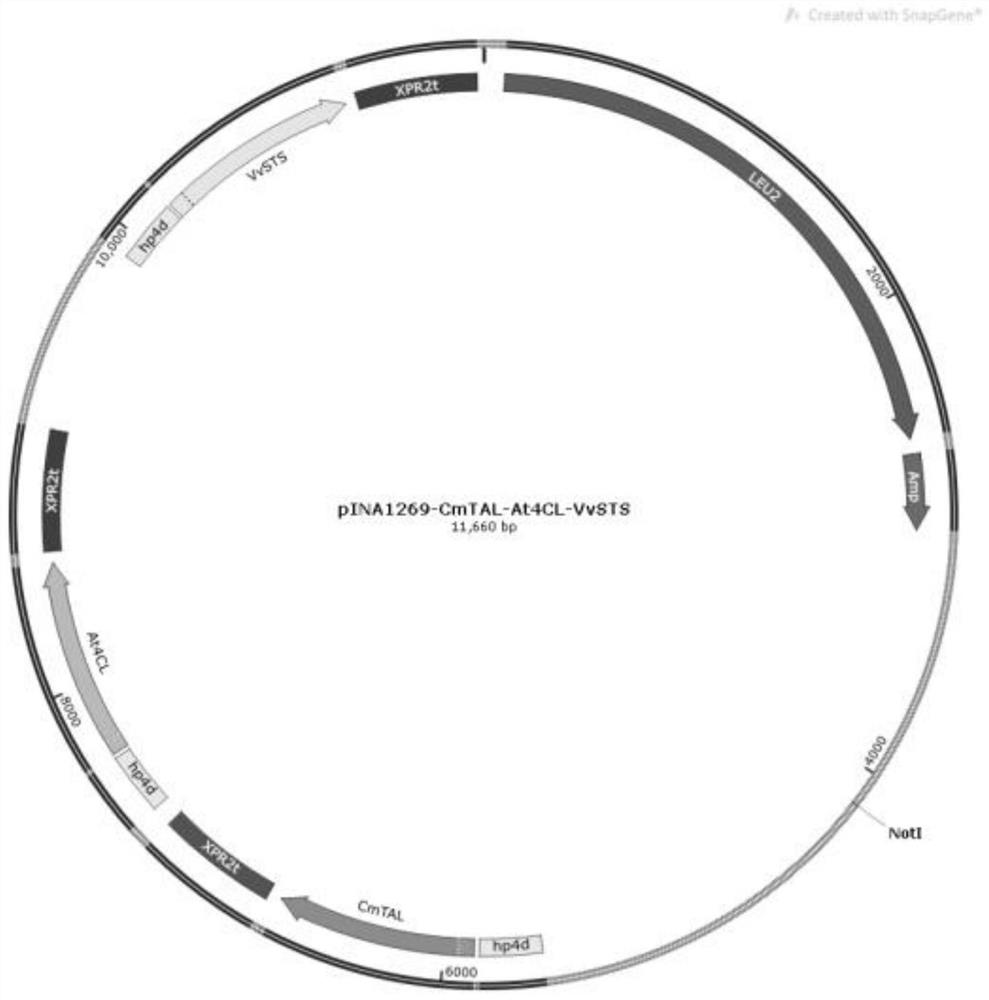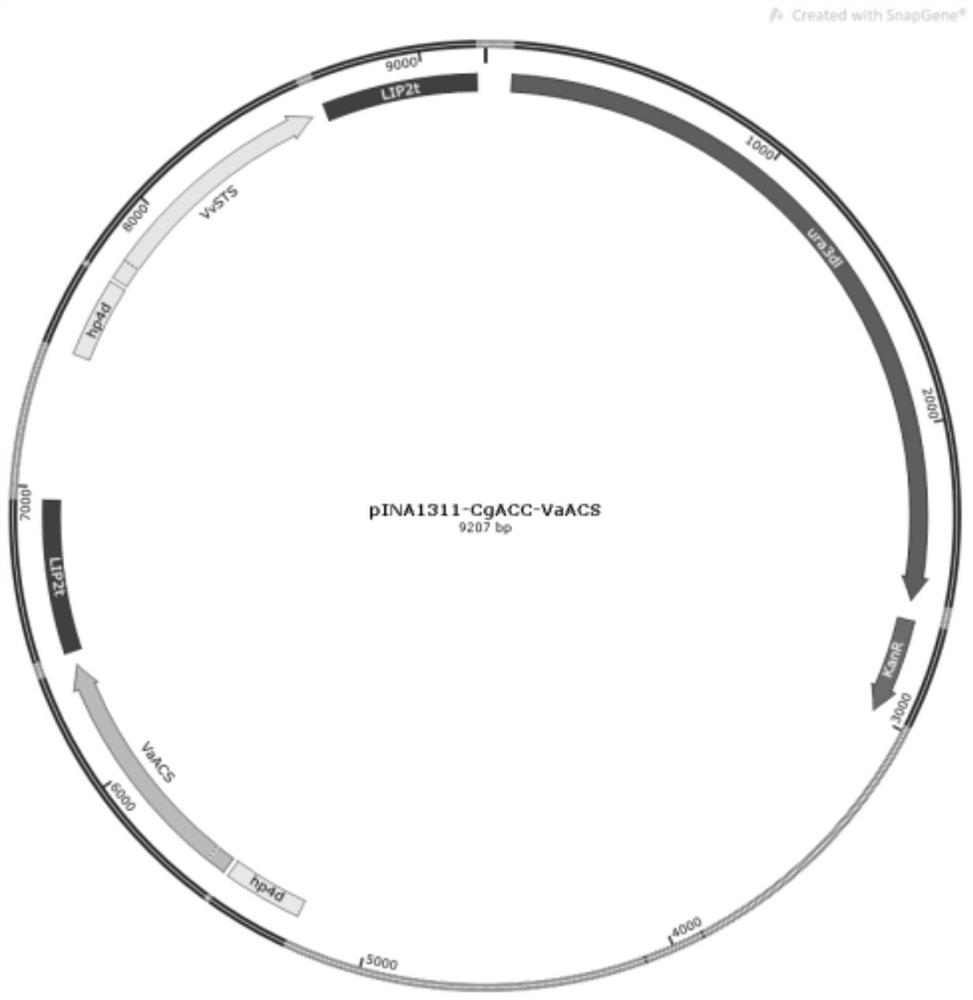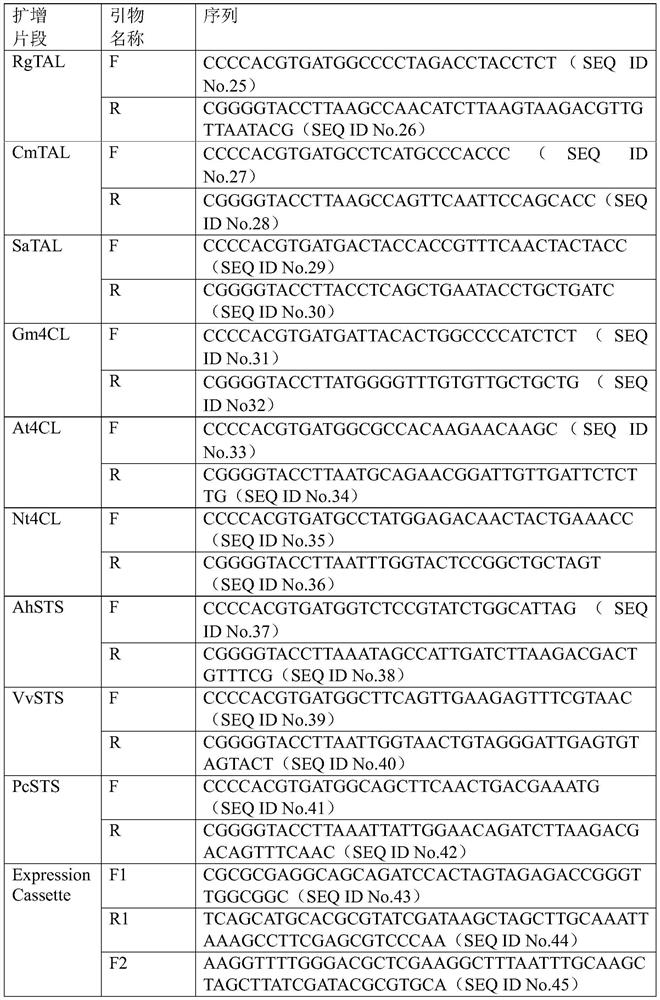Engineering bacterium for biosynthesizing resveratrol by taking L-tyrosine as substrate, construction and application
A technology for resveratrol and biosynthesis, applied in the biological field, can solve problems such as difficulties, chemical synthesis pollution safety, questioned promotion, etc., and achieve the effect of increasing the content
- Summary
- Abstract
- Description
- Claims
- Application Information
AI Technical Summary
Problems solved by technology
Method used
Image
Examples
Embodiment 1p
[0042] Construction method of embodiment 1pINA1269-TAL-4CL-STS plasmid
[0043] 1. Construction of pINA1269-TAL, pINA1269-4CL and pINA1269-STS plasmids
[0044] (1) Using the artificially synthesized RgTAL gene (as a template, carry out PCR amplification with primers RgTAL-F and RgTAL-R, and recover the target fragment RgTAL.
[0045] (2) Using the artificially synthesized Gm4CL gene as a template, PCR amplification was performed with primers Gm4CL-F and Gm4CL-R, and the target fragment Gm4CL was recovered.
[0046] (3) Using the artificially synthesized AhSTS gene as a template, PCR amplification was carried out with primers AhSTS-F and AhSTS-R, and the target fragment AhSTS was recovered.
[0047] (4) Using the artificially synthesized CmTAL gene as a template, PCR amplification was performed with primers CmTAL-F and CmTAL-R, and the target fragment CmTAL was recovered.
[0048] (5) Using the artificially synthesized At4CL gene as a template, PCR amplification was performe...
Embodiment 2
[0073] Embodiment 2 Construction of Yarrowia lipolytica engineering bacteria and shake flask fermentation
[0074] (1) The plasmids pINA1269-RgTAL-Gm4CL-AhSTS, pINA1269-CmTAL-At4CL-VvSTS, and pINA1269-SaTAL-Nt4CL-PcSTS obtained in Example 1 were digested with restriction endonuclease NotI, linearized and then transformed with LiAC Transform into Yarrowia lipolytica Po1f, spread it on SC-Leu yeast-deficient medium, culture at 30°C until transformants grow, pick positive transformants, and obtain the initial project capable of producing resveratrol Strain 1, engineering strain 2 and engineering strain 3.
[0075] (2) Streak the engineering strain 1, engineering strain 2 and engineering strain 3 on the YPD medium and cultivate until a single colony grows, pick a single colony, inoculate it into the seed medium, and cultivate it for 15 hours to obtain the seed liquid. Said seed medium is YPD medium: 20g / L glucose is the carbon source, contains yeast extract 10g / L, peptone 20g / L, ...
Embodiment 3
[0084] Example 3 Expression of acetyl-CoA carboxylase (ACC) increases resveratrol production
[0085] 1. Construction of pINA1311-ACC plasmid
[0086] (1) artificially synthesized CgACC (sequence as described in SEQ ID No.10, length 1776bp), AsACC (sequence as described in SEQ ID No.11, length 6699bp), CaACC gene (sequence as described in SEQ ID No.12 described above, with a length of 6693bp) as a template, respectively utilize CgACC-F and CgACC-R, AsACC-F and AsACC-R, CaACC-F and CaACC-R to carry out PCR amplification, and the amplified products are recovered to obtain CgACC, AsACC , the target fragment of CaACC, the fragment sizes are 1776bp, 6699bp, 6693bp respectively, the primer CgACC-F sequence 5'-CCCCACGTGATGTCTGTTGAAACAAGAAAAAATAACCAAAGTGC-3', as described in SEQ ID No.47, the primer CgACC-R sequence 5' -CGGGGTACCTTATTTGATTTCCAATAAAACCACTCCTTTGTTAACAG-3', as described in SEQ ID No.48; said primer AsACC-F sequence 5'-CCCCACGTGATGAGCGCGTATGATCAT-3', as described in SEQ ...
PUM
 Login to View More
Login to View More Abstract
Description
Claims
Application Information
 Login to View More
Login to View More - R&D
- Intellectual Property
- Life Sciences
- Materials
- Tech Scout
- Unparalleled Data Quality
- Higher Quality Content
- 60% Fewer Hallucinations
Browse by: Latest US Patents, China's latest patents, Technical Efficacy Thesaurus, Application Domain, Technology Topic, Popular Technical Reports.
© 2025 PatSnap. All rights reserved.Legal|Privacy policy|Modern Slavery Act Transparency Statement|Sitemap|About US| Contact US: help@patsnap.com



